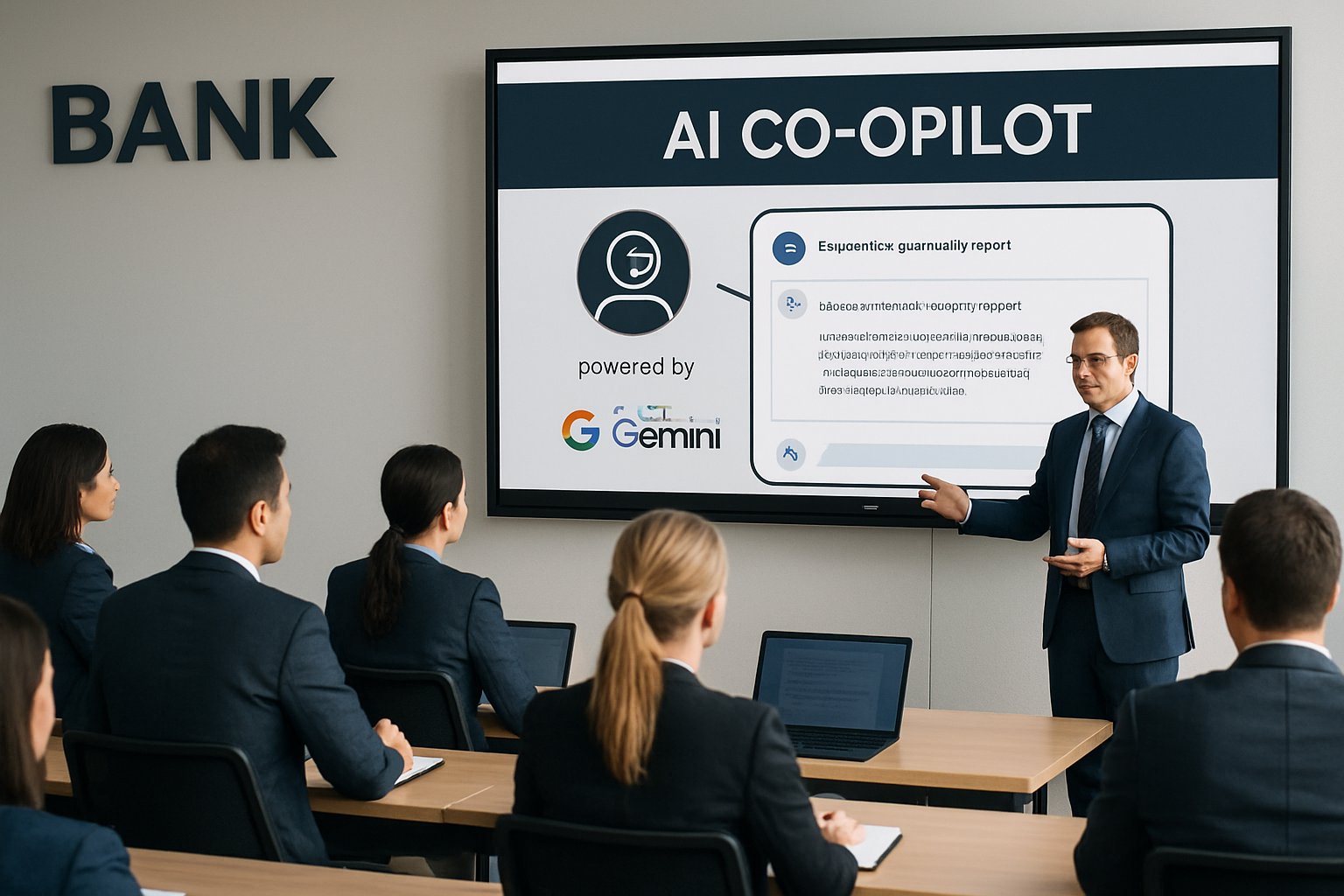
AI CERTS
14 hours ago
Credem Bank Bets on AI Workforce Augmentation With Google Gemini
Moreover, analysts see the partnership as another proof point that European finance is accelerating toward systematic AI Workforce Augmentation. In contrast, unions warn that automation could redistribute work unevenly without transparent metrics. This article dissects the rollout drivers, expected gains, governance hurdles, and next actions for banking leaders. Readers will gain a concise roadmap for evaluating similar enterprise copilots within strict regulatory boundaries.
Bank Unveils Gemini Rollout
On the announcement day, Credem confirmed immediate deployment of Google Workspace enhanced by Gemini across knowledge workers. Furthermore, management is evaluating Gemini Enterprise and Vertex AI for specialised agents automating multistep tasks. However, cost details remain undisclosed, yet executives stressed alignment with a multiyear cloud roadmap. Piergiorgio Grossi, Chief Innovation & Data Officer, said the aim is to “dedicate more time to high-value activities.” Therefore, Credem positioned the rollout as the first pillar of broad AI Workforce Augmentation inside the organisation.

These facts confirm Credem’s intent to modernise workflows rapidly. Subsequently, deeper technical adoption will define long-term success metrics.
Key Drivers Of Adoption
Several internal and external pressures shaped Credem’s decision timeline. Firstly, customer expectations for instant information digest demand highly responsive staff tools. Additionally, regulatory reporting loads continue rising under DORA and the evolving EU AI Act. Consequently, leadership needs automation that reduces manual data extraction while maintaining auditable logs. Moreover, bank assets topped EUR 67.97 billion in 2024, indicating operational scale where time savings compound. Analysts note similar initiatives worldwide claim double-digit efficiency gains through AI Workforce Augmentation. In contrast, early adopters also report governance overhead that offsets part of the speed boost.
These drivers demonstrate urgent demand for scalable solutions. Therefore, Credem’s enterprise copilots evaluation appears commercially unavoidable.
Enterprise Copilots Strategy Roadmap
Credem labels Gemini-powered assistants as enterprise copilots capable of summarising policies, drafting emails, and generating meeting notes. Furthermore, the bank pilots agent workflows that query internal databases, compile credit assessments, and schedule customer interactions autonomously. Gemini Enterprise offers role-based controls, while Vertex AI supplies model monitoring, version pinning, and synthetic data testing. Moreover, Credem plans to integrate these components with existing orchestration systems, ensuring tasks trigger downstream approvals automatically.
- Summarise 100-page risk dossiers in seconds
- Draft personalised client emails in multiple languages
- Generate audit-ready action logs for compliance
These enterprise copilots promise rapid productivity transformation if guardrails work as designed. Subsequently, measurement will validate their effectiveness.
Productivity Metrics And Training
Quantifying gains remains essential for credible AI Workforce Augmentation narratives. Therefore, Credem is defining key performance indicators covering time saved per task, document turnaround, and customer satisfaction shifts. Additionally, management committed to 30,000 hours of employee training before year-end, blending e-learning modules and live workshops. The curriculum spans prompt engineering, ethical safeguards, and hands-on certification paths. Professionals can reinforce skills through the AI + Foundation Certification, which aligns with Google Cloud competencies.
- Time per policy summary: target 60% reduction
- Manual data entry incidents: target 40% reduction
- Average customer query resolution: target 25% acceleration
These metrics anchor the promised productivity transformation to concrete numbers. Consequently, transparent reporting will build stakeholder trust.
Governance And Regulatory Lens
Financial regulators now examine generative tools through the EU AI Act and DORA frameworks. Consequently, Credem must demonstrate risk classifications, human oversight, and incident response playbooks for every AI function. Furthermore, data residency, encryption, and no-training clauses will enter contracts with Google Cloud. In contrast, failure to document controls could trigger supervisory findings or fines. Moreover, Vertex AI’s monitoring dashboards help audit model drift, while Gemini Enterprise logs support forensic review.
Governance demands add overhead yet safeguard trust. Subsequently, they legitimise AI Workforce Augmentation within strict European rules.
Risks And Bank Mitigations
Every innovation carries risk, and generative AI is no exception. However, hallucinations can mislead staff, so Credem mandates human validation for all critical outputs. Additionally, the bank imposes usage policies limiting sensitive data exposure inside prompts. Nevertheless, labour groups fear automation could erode roles despite upskilling promises. Credem counters with redeployment programs and wellness initiatives under its “Wellbanking” umbrella. Moreover, clear communication channels allow employees to flag inaccuracies or policy gaps rapidly.
These mitigations aim to balance innovation with responsibility. Therefore, ongoing dialogue will refine safeguards as enterprise copilots evolve.
Future Outlook And Actions
Industry observers expect rapid replication of Credem’s model across mid-tier European banks. Consequently, competitive pressure may accelerate hiring for prompt-design and governance specialists. Meanwhile, proof points from Klarna and Microsoft suggest double-digit efficiency gains are realistic within 12 months. However, institutions lacking robust metrics risk overpromising stakeholders and regulators. Therefore, leaders should test AI Workforce Augmentation in controlled pilots, measure rigorously, and iterate governance playbooks.
These prospects underscore a decisive moment for banking technology. Subsequently, structured experimentation will separate winners from laggards.
Ultimately, Credem’s experience shows that AI Workforce Augmentation succeeds when technology, metrics, and culture align. Furthermore, disciplined pilots convert lofty innovation slogans into measurable productivity transformation within regulatory guardrails. Consequently, boards can allocate capital confidently while supervisors receive transparent evidence of risk control. Banks planning similar AI Workforce Augmentation efforts should benchmark Credem’s training pledge and governance stack immediately. Moreover, embedding AI assistants into daily workflows will accelerate productivity transformation across front-office and compliance functions. Nevertheless, continuous measurement remains vital, because AI Workforce Augmentation without KPIs risks stakeholder backlash. Ready to start your journey? Explore the AI + Foundation Certification and equip your teams for responsible deployment today.



